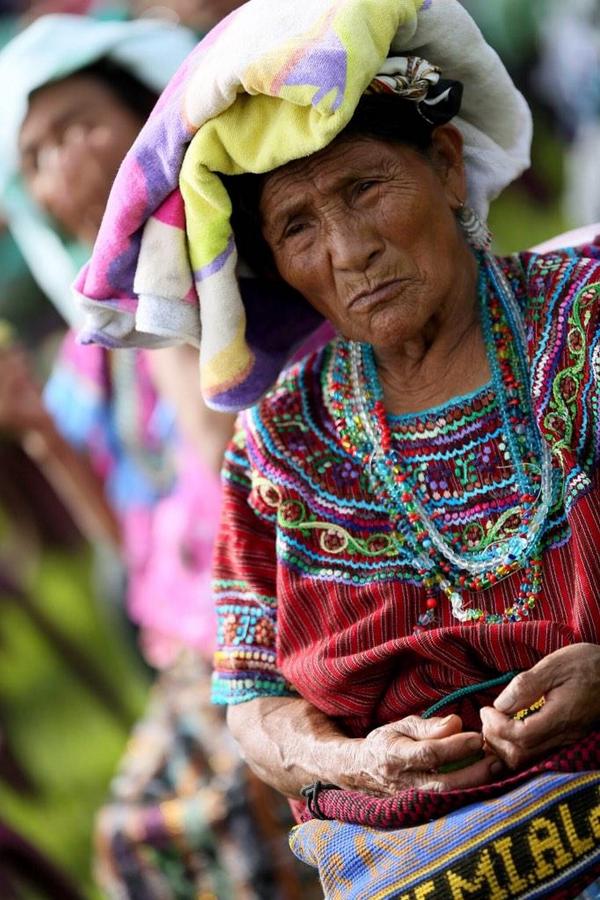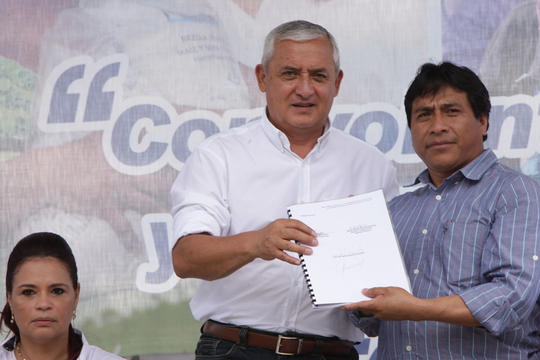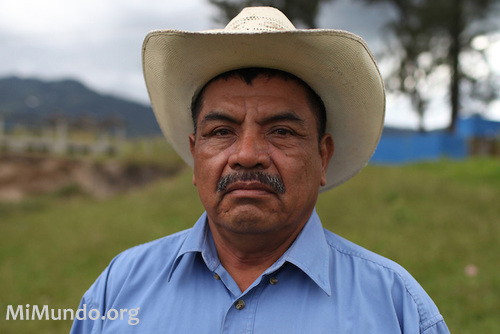By: By Monti Aguirre, Latin American Program Director
On Saturday, March 13, 1982, a young Maya Achi man named Carlos Chen’s life was forever altered. That day, he painfully learned that his wife Paulina Iboy, children Enriqueta and Antonio, and sisters Marta Julia and Bernarda, had been viciously massacred. They – along with many others – were brutally tortured and murdered, then their bodies were thrown in a nearby creek and a mass grave. Their crime? Living on land the military dictatorship wanted to flood for a hydroelectric dam.
By the time the Chixoy Dam was completed in 1985, more than 400 Maya Achi people had been massacred, thousands more displaced, and the livelihoods of 11,200 families subverted.
The survivors of the massacre were eventually moved to a village built for the displaced people, named Pacux. But their living conditions have always been bad, and they’ve lacked access to adequate housing, health care, electricity, water, education, and employment.

After the military dictatorship fell, some survivors began to fight for reparations. And so in the 1990s, they partnered with international human rights organizations to begin a decades-long struggle for justice against the dam builder and funders.
Who built the dam? The government of Guatemala. Who funded the dam? The World Bank and the Inter-American Development Bank. Who suffered, were massacred and never gained any benefits from the dam? The Maya Achi people.
I remember once crossing the reservoir with Carlos on a boat. He made the boat stop and pointed to the water to tell me “this is where Los Encuentros village used to be. We used to meet here on Sundays and exchange our products. Many massacred peoples are still here in this reservoir.”
Many people thought it impossible that the Maya Achi indigenous people would ever get reparations for damages caused by construction of the Chixoy Dam. Dam reparations had never happened before.
But the perseverance of the people in the Coordinating Committee of the Communities Affected by the Chixoy Dam (COCAHICH) and the savvy negotiations skills of Maya Achi leaders paid off. Carlos Chen became one of those leaders.Residents of the 33 communities affected by construction of the Chixoy Dam received the Reparations Agreement from the President, which will begin to be implemented in 2015.Photo courtesy of the President of Guatemala, via soy502.com

On Saturday, November 8th 2014, Carlos and hundreds of community members were part of a historical event in Rabinal, a town close to the resettlement of Pacux. On a brisk Saturday afternoon, the sun peeked out from behind plump gray clouds as Guatemala’s President Otto Perez Molina asked forgiveness from the communities for the government’s role in the social, cultural and environmental destruction caused by the Chixoy Dam.
That afternoon, President Perez Molina presented the Reparations Executive Agreement, which operationalizes reparations for the 33 communities who were drastically impacted by the construction of dam. The Agreement includes more than US$154.5 million to fund individual compensations, infrastructure, development assistance and environmental restoration.
“It is the obligation of the State to repair the damages,” said Juan de Dios Garcia, a COCAHICH leader, many times when we discussed the process to make reparations a reality. While obtaining reparations is indeed a well-deserved victory for the Maya Achi, Juan was able to put this victory in perspective. “What we want most is the end of this type of human rights violations. The international financial institutions, governments and investors should stop manipulating communities and deceiving people to build their projects.”President Perez Molina and Juan de Dios Garcia with the Reparations Agreement. November 8, 2014Photo courtesy of soy502.com
Governments and financiers seldom step up to take responsibility for the damages caused by development projects they build and finance. The World Bank and the Inter-American Development Bank for many years failed to recognize their obligations to address reparations for these communities, even though community leaders and their advocates sent letters and declarations and made numerous visits to Bank officials.
Then in 2008, something changed. Beginning that year, Bank representatives, government officials and community leaders participated in a negotiations roundtable for reparations. After many revisions, all sides finally agreed upon the Reparations Plan of 2010. But political and economic interests got in the way and the plan was never implemented.
It was not until January of 2014 – when the US Congress instructed the Banks to ensure implementation of the Chixoy Reparations Plan of 2010 – that the Banks began to pressure the government of Guatemala to address reparations. The US Congress made new loans to Guatemala conditional until the Guatemalan government moved to begin implementing the 2010 Reparation Agreement. With this pressure from the US Congress, the Banks in turn pressured the government of Guatemala to address reparations. And so the plan, four years later, gained traction.
While the solemn ceremony at the stadium in Rabinal on November 8 marked the culmination of the negotiations process for Carlos and the rest of the Maya Achi survivors, it also sets the beginning of another long, hard process – repairing the social, cultural, emotional, physical and environmental scars left by the Chixoy Dam. The Guatemalan government still needs to approve the 2015 budget allocating funds to pay for these reparations, and it is still unclear where funds will come from.This is the photograph that hangs behind my desk. Nicolas Chen, a survivor from Rio Negro, caresses the photograph of his daughter, Marta Julia Chen Osorio. He is also the father of Carlos Chen, principal negotiator for COCAHICH. Photo taken in Rabinal, Guatemala. July 27, 2007Original photo by James A. Rodríguez/MiMundo.org. Cannot be reproduced without permission.
Since I started working on this campaign with the Maya Achi in the 1990s, International Rivers has maintained that the World Bank and the Inter-American Development Bank must take responsibility and pay reparations to the Maya Achi people. Carlos and Juan are hopeful funds will be made available early next year. We at International Rivers also remain hopeful and insist that the Banks make no-interest loans to pay their long-due debt to Maya Achi communities affected by the Chixoy Dam.
Life will never the same for the Maya Achi. Their loved ones, whose lives were taken to make way for the dam, will not come back. But the Maya Achi will begin to restore their lives, restore their dignity. International Rivers congratulates them and we are proud to have been a part of this process.
Featured image: Portrait of Carlos Chen at the Pacux resettlement village in the outskirts of Rabinal | Photo by: James A. Rodríguez/MiMundo.org. Cannot be reproduced without permission.

